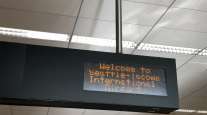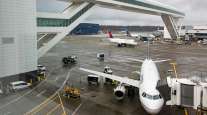The Seattle Times
'All Hands On Deck’ at Seattle, Tacoma Ports

[Stay on top of transportation news: Get TTNews in your inbox.]
Seattle and Tacoma port authorities said Oct. 13 it’s “all hands on deck” as they work to address cargo ship congestion in Puget Sound.
“We are seeing unprecedented times in the global supply chain,” said John Wolfe, CEO of The Northwest Seaport Alliance, which oversees container traffic for both the Port of Seattle and Port of Tacoma.
Wolfe said there were currently about 15 cargo vessels still awaiting berth at the ports. In ordinary times, a port spokesperson said, there typically aren’t any cargo vessels at anchor in Puget Sound, and they can go directly to dock at the container terminals.
But the local ports are not turning to the kind of round-the-clock, all-week operation that President Joe Biden announced the Port of Los Angeles would move to. Wolfe said NWSA was “looking at” expanded gate hours at the ports’ container terminals, but “that alone is not going to fix this problem.”
While terminal hours are one part of the equation, Wolfe said trucks moving containers from terminals to warehouses are also in short supply, and warehouses are already full, leaving little room to store new incoming containers.

(Tim Rue/Bloomberg News)
READ MORE
“When any portion of the supply chain starts to be stretched to the limits, it’s like a domino effect,” said Wolfe, at a video news conference after Biden’s speech. “When one domino falls ... the other pieces of the supply chain then start to fail, and that’s what we’re experiencing.”
NWSA said it has already started taking measures to address the crunch. While shipping terminals in Seattle and Tacoma are usually open Monday to Friday from 7 a.m. to 5 p.m., terminal operators have been adding some extra night shifts between 6 p.m. and 3 a.m., and some terminals have offered Saturday operations. Until now, those extended hours have been sporadic. NWSA said they would like to see those extended hours become more standardized, but that will rely on discussions with terminal operators who make the final decision.
Wolfe also said the ports have begun accepting empty shipping container returns so truck drivers can quickly pick up full containers and be on their way. And he said the ports are working with importers who are slow to pick up their shipping containers at terminals, to address the root causes for their delay.

Containers are stacked at a dock south of downtown Seattle on Oct. 13. (Greg Gilbert/The Seattle Times/TNS)
Eric Wright, vice president at the Washington Trucking Association, said in an interview there are plenty of truck drivers to satisfy port operations, but the more significant issue is a shortage of chassis — the trailers that trucks use to carry containers. When trucks drop off containers on chassis at warehouses, he said, there are often delays in unloading the containers and freeing up those chassis to return to the port for another round of pickups.
Having so many ships awaiting berth could become a safety concern as weather gets worse and wind speeds rise, said Fred Felleman, president of the Port of Seattle Commission. The port “could see vessels loitering offshore, which is a safety concern.”
The congestion has been a result of surging consumer demand in North America. And with the holiday rush coming up, Felleman said, “it’s going to get worse before it gets better.”
Want more news? Listen to today's daily briefing below or go here for more info:
Distributed by Tribune Content Agency, LLC



